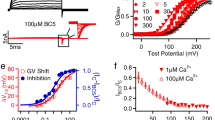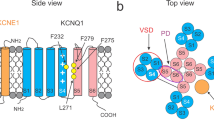Abstract
The voltage-sensor domain (VSD) and the ligand sensor (cytoplasmic domain) of BK channels synergistically control channel activities, thereby integrating electrical and chemical signals for cell function. Studies show that intracellular Mg2+ mediates the interaction between these sensory domains to activate the channel through an electrostatic interaction with the VSD. Here we report that Mg2+ binds to a site that consists of amino acid side chains from both the VSD (Asp99 and Asn172) and the cytoplasmic domain (Glu374 and Glu399). For each Mg2+ binding site, the residues in the VSD and those in the cytoplasmic domain come from neighboring subunits. These results suggest that the VSD and the cytoplasmic domains from different subunits may interact during channel gating, and the packing of VSD or the RCK1 domain to the pore in BK channels differ from that in Kv1.2 or MthK channels.
This is a preview of subscription content, access via your institution
Access options
Subscribe to this journal
Receive 12 print issues and online access
$189.00 per year
only $15.75 per issue
Buy this article
- Purchase on Springer Link
- Instant access to full article PDF
Prices may be subject to local taxes which are calculated during checkout







Similar content being viewed by others
References
Hille, B. Ion Channels Of Excitable Membranes (Sinauer, Sunderland, MA, 2001).
Long, S.B., Campbell, E.B. & Mackinnon, R. Voltage sensor of Kv1.2: structural basis of electromechanical coupling. Science 309, 903–908 (2005).
Jiang, Y. et al. Crystal structure and mechanism of a calcium-gated potassium channel. Nature 417, 515–522 (2002).
Miyazawa, A., Fujiyoshi, Y. & Unwin, N. Structure and gating mechanism of the acetylcholine receptor pore. Nature 423, 949–955 (2003).
Latorre, R. & Brauchi, S. Large conductance Ca2+-activated K+ (BK) channel: activation by Ca2+ and voltage. Biol. Res. 39, 385–401 (2006).
Magleby, K.L. Gating mechanism of BK (Slo1) channels: so near, yet so far. J. Gen. Physiol. 121, 81–96 (2003).
Salkoff, L., Butler, A., Ferreira, G., Santi, C. & Wei, A. High-conductance potassium channels of the SLO family. Nat. Rev. Neurosci. 7, 921–931 (2006).
Hou, S., Xu, R., Heinemann, S.H. & Hoshi, T. Reciprocal regulation of the Ca2+ and H+ sensitivity in the SLO1 BK channel conferred by the RCK1 domain. Nat. Struct. Mol. Biol. 15, 403–410 (2008).
Hou, S., Xu, R., Heinemann, S.H. & Hoshi, T. The RCK1 high-affinity Ca2+ sensor confers carbon monoxide sensitivity to Slo1 BK channels. Proc. Natl. Acad. Sci. USA 105, 4039–4043 (2008).
Tang, X.D. et al. Haem can bind to and inhibit mammalian calcium-dependent Slo1 BK channels. Nature 425, 531–535 (2003).
Zeng, X.H., Xia, X.M. & Lingle, C.J. Divalent cation sensitivity of BK channel activation supports the existence of three distinct binding sites. J. Gen. Physiol. 125, 273–286 (2005).
Shi, J. et al. Mechanism of magnesium activation of calcium-activated potassium channels. Nature 418, 876–880 (2002).
Xia, X.M., Zeng, X. & Lingle, C.J. Multiple regulatory sites in large-conductance calcium-activated potassium channels. Nature 418, 880–884 (2002).
Yang, H. et al. Mg2+ mediates interaction between the voltage sensor and cytosolic domain to activate BK channels. Proc. Natl. Acad. Sci. USA 104, 18270–18275 (2007).
Ledoux, J., Werner, M.E., Brayden, J.E. & Nelson, M.T. Calcium-activated potassium channels and the regulation of vascular tone. Physiology (Bethesda) 21, 69–78 (2006).
Toro, L., Wallner, M., Meera, P. & Tanaka, Y. Maxi-KCa, a unique member of the voltage-gated K channel superfamily. News Physiol. Sci. 13, 112–117 (1998).
Fettiplace, R. & Fuchs, P.A. Mechanisms of hair cell tuning. Annu. Rev. Physiol. 61, 809–834 (1999).
Du, W. et al. Calcium-sensitive potassium channelopathy in human epilepsy and paroxysmal movement disorder. Nat. Genet. 37, 733–738 (2005).
Ma, Z., Lou, X.J. & Horrigan, F.T. Role of charged residues in the S1–S4 voltage sensor of BK channels. J. Gen. Physiol. 127, 309–328 (2006).
Jiang, Y., Pico, A., Cadene, M., Chait, B.T. & MacKinnon, R. Structure of the RCK domain from the E. coli K+ channel and demonstration of its presence in the human BK channel. Neuron 29, 593–601 (2001).
Fodor, A.A. & Aldrich, R.W. Statistical limits to the identification of ion channel domains by sequence similarity. J. Gen. Physiol. 127, 755–766 (2006).
Yang, H., Hu, L., Shi, J. & Cui, J. Tuning magnesium sensitivity of BK channels by mutations. Biophys. J. 91, 2892–2900 (2006).
Dudev, T. & Lim, C. Principles governing Mg, Ca, and Zn binding and selectivity in proteins. Chem. Rev. 103, 773–788 (2003).
Hu, L., Yang, H., Shi, J. & Cui, J. Effects of multiple metal binding sites on calcium and magnesium-dependent activation of BK channels. J. Gen. Physiol. 127, 35–50 (2006).
Horrigan, F.T. & Aldrich, R.W. Allosteric voltage gating of potassium channels II. Mslo channel gating charge movement in the absence of Ca2+. J. Gen. Physiol. 114, 305–336 (1999).
Horrigan, F.T. & Aldrich, R.W. Coupling between voltage sensor activation, Ca2+ binding and channel opening in large conductance (BK) potassium channels. J. Gen. Physiol. 120, 267–305 (2002).
Horrigan, F.T. & Ma, Z. Mg2+ enhances voltage sensor/gate coupling in BK channels. J. Gen. Physiol. 131, 13–32 (2008).
Hazes, B. & Dijkstra, B.W. Model building of disulfide bonds in proteins with known three-dimensional structure. Protein Eng. 2, 119–125 (1988).
Flynn, G.E. & Zagotta, W.N. Conformational changes in S6 coupled to the opening of cyclic nucleotide-gated channels. Neuron 30, 689–698 (2001).
Long, S.B., Campbell, E.B. & Mackinnon, R. Crystal structure of a mammalian voltage-dependent Shaker family K+ channel. Science 309, 897–903 (2005).
Wallner, M., Meera, P. & Toro, L. Determinant for β-subunit regulation in high-conductance voltage-activated and Ca2+-sensitive K+ channels: an additional transmembrane region at the N terminus. Proc. Natl. Acad. Sci. USA 93, 14922–14927 (1996).
Cox, D.H., Cui, J. & Aldrich, R.W. Allosteric gating of a large conductance Ca-activated K+ channel. J. Gen. Physiol. 110, 257–281 (1997).
Dudev, T., Lin, Y.L., Dudev, M. & Lim, C. First-second shell interactions in metal binding sites in proteins: a PDB survey and DFT/CDM calculations. J. Am. Chem. Soc. 125, 3168–3180 (2003).
Shi, J. & Cui, J. Intracellular Mg2+ enhances the function of BK-type Ca2+-activated K+ channels. J. Gen. Physiol. 118, 589–606 (2001).
Zhang, X., Solaro, C.R. & Lingle, C.J. Allosteric regulation of BK channel gating by Ca2+ and Mg2+ through a nonselective, low affinity divalent cation site. J. Gen. Physiol. 118, 607–636 (2001).
Zhang, G. & Horrigan, F.T. Cysteine modification alters voltage- and Ca2+-dependent gating of large conductance (BK) potassium channels. J. Gen. Physiol. 125, 213–236 (2005).
Acknowledgements
We thank L. Hu for calculations of Mg2+ sensitivity according to the model of the intersubunit Mg2+ binding site. We thank C. Lingle, L. Salkoff and L. Hu for critical discussion. The mouse Slo1 clone was provided by L. Salkoff (Washington University). F. Horrigan (Baylor College of Medicine) provided the Y163K mutant mouse Slo1 cDNA. This work was supported by the US National Institutes of Health Grant R01-HL70393 and the National Science Foundation of China Grant 30528011 (J.C.). J.C. is funded by the Spencer T. Olin Endowment.
Author information
Authors and Affiliations
Contributions
H.Y., J.S. and J.C. designed the research; H.Y., J.S., G.Z., J.Y. and K.D. performed the experiments; H.Y., G.Z. and J.Y. analyzed the data; H.Y. and J.C. wrote the paper.
Corresponding author
Supplementary information
Supplementary Text and Figures
Supplementary Figures 1 and 2 (PDF 265 kb)
Rights and permissions
About this article
Cite this article
Yang, H., Shi, J., Zhang, G. et al. Activation of Slo1 BK channels by Mg2+ coordinated between the voltage sensor and RCK1 domains. Nat Struct Mol Biol 15, 1152–1159 (2008). https://doi.org/10.1038/nsmb.1507
Received:
Accepted:
Published:
Issue Date:
DOI: https://doi.org/10.1038/nsmb.1507
This article is cited by
-
Structural basis for gating the high-conductance Ca2+-activated K+ channel
Nature (2017)
-
Cryo-EM structure of the open high-conductance Ca2+-activated K+ channel
Nature (2017)
-
Cryo-electron microscopy structure of the Slo2.2 Na+-activated K+ channel
Nature (2015)
-
BK channel activation by tungstate requires the β1 subunit extracellular loop residues essential to modulate voltage sensor function and channel gating
Pflügers Archiv - European Journal of Physiology (2014)
-
Voltage sensor of ion channels and enzymes
Biophysical Reviews (2012)



